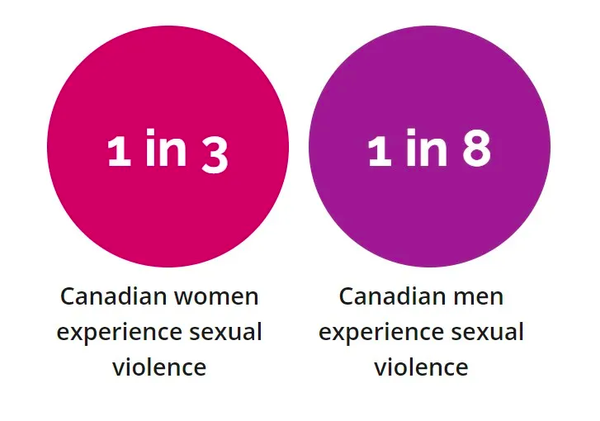Toronto Rape Crisis Center - Multicultural Women Against Rape
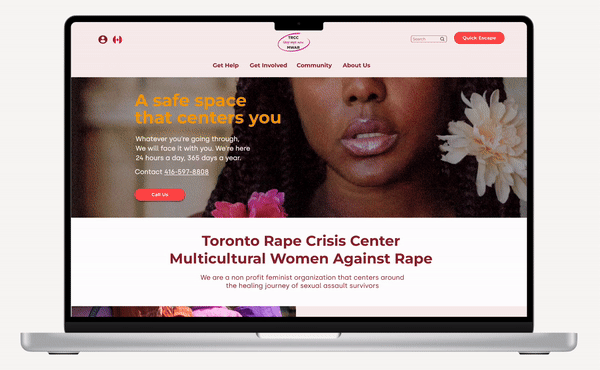
The Toronto Rape Crisis Centre/Multicultural Women Against Rape (TRCC/MWAR) is a grassroots, women, and non-binary people run collective. The organization work towards a violence-free world by providing anti-oppressive, feminist peer support to survivors of gender-based or sexual violence.
Design Brief
The objective is to build a website for Toronto Rape Crisis Center / Multicultural Women Against Rape (TRCC/MWAR). The website aims to provide emergent services and a place of community for sexual assault survivors where they feel safe and empowered.
Project Summary
-
The objective is to build a mock-up website that provides emergent services and a place of community for sexual assault survivors where they feel safe and empowered.
Business Goal
-
To render TRCC mission in the digital space. TRCC/MWAR’s mission is to support to survivors of sexual violence through counselling, group support, education, activism and receive funding.
-
A safe place for survivors to express themselves through community building
Website Goal
-
Build a landing page that assists survivor’s needs when it comes to their intuitive healing process through emergent call to action prompts to access crisis line and other information they require for their healing
-
Highlight the crisis line as TRCC’s way of immediately getting in touch with a survivor.
-
To raise awareness of women’s liberation through a readable and usable website
-
To provide a space to encourage community engagement by getting involved in virtual events and services
Obstacles
-
Equality in gender in litigious ways in accessing funding and other types of immediate assistance
-
Creating a user journey map for users may trigger flashbacks
-
The usage of vocabulary to identify the words to describe what they experienced to make it less triggering for survivors.
-
Older members aren’t fully accustomed to the digital landscape
User Persona
-
Survivors of all races, classes, ages, gender identities, sexual orientations, abilities, and spiritualities.
Site Map
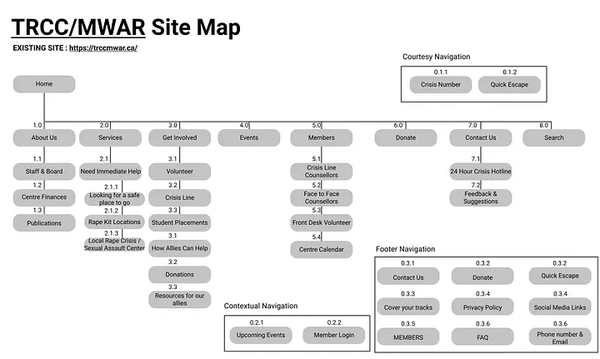
I built a site map of the existing website of TRCC so I can explore and understand the contents of their site.
Existing site map of TRCC/MWAR website.
I rearranged the site the way a person with trauma would normally seek something.
A survivor normally has difficulty in the following:
-
looking for who to call.
-
Getting resources quickly
-
how to find them while confused
I highlighted the top 4 emergent needs of a survivor. These are immediate ways to funnel through more resources that a victim needs for healing.
-
Get Help
-
Community
-
About Us
-
How can I help

I added the subcategories such as wellness, healing, arts and culture, education because these are the usual route that a survivor goes in terms of nurture and care. Some of these activities were already available in the physical premises of TRCC/MWAR such as writing classes and sexuality.
Language is also an important tool in the Courtesy navigation because one of TRCC/MWAR’s philosophy is inclusive of all race — meaning there should be translation option if a victim doesn’t speak nor understand English.
Community — a sense of belongingness that a victim doesn’t have to go through this alone. A community designed to thrive. Tune into daily classes across wellness & culture, make connections with a thriving community facilitated by sexual assault survivors and allies.
Highlighting the TRCC community in the digital space helps survivors become more engaged in their healing. Being surrounded with validation and acceptance is what a community is all about. The community is what makes survivors come back to TRCC.
User Journey
Knowing the risk of triggering other survivors when they are being interviewed as they are revisiting their trauma. I took the initiative to map out my own sexual assault journey on how I came about TRCC/MWAR’s website. So I created a user journey map. This was probably the most difficult and the most rewarding part of the research because I was observing my own feelings and experience on what I went through in order to seek help and provide possible solutions out of my own unpleasant experience.
Customer Journey
Knowing the risk of triggering other survivors when they are being interviewed as they are revisiting their trauma. I took the initiative to map out my own sexual assault journey on how I came about TRCC/MWAR’s website. So I created a user journey map. This was probably the most difficult and the most rewarding part of the research because I was observing my own feelings and experience on what I went through in order to seek help and provide possible solutions out of my own unpleasant experience.

Through this user journey I was able to identify the needs and frustration of the user (which is me right now). The narrative that the user had at that time was
“I am confused and afraid. I need help but not sure how I can be helped”
Which basically means the survivor needs someone she can talk to whom she can safely express what she’s going through and at the same time understand where she’s coming from.
Mood board + Comparative Analysis
I did a comparative analysis of websites that uphold the objective of emergent responses such as Crisis Text Line and Samaritan. I added Ethel’s Club as a reference on what a thriving online community looks like. I wanted to marry the two ideas together.
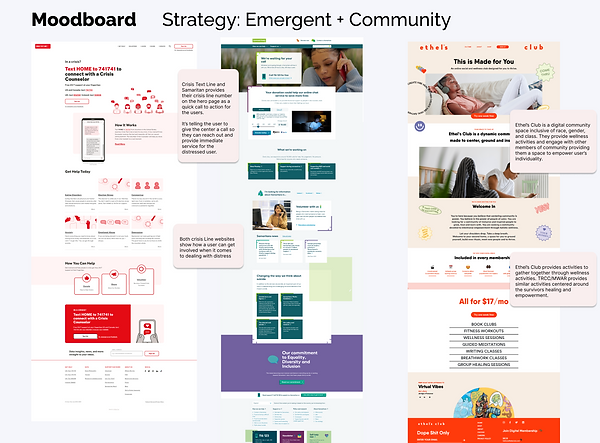
Wireframes
Wireframe 1
I was able to create wireframes on how the website could potentially look like. The site map was able to provide a structure on how to start building a wireframe around that idea.
I started with this wireframe that provides the essential information a user would like to see on their landing page.
-
Seek help
-
services provided
-
how people can get involved
-
community
I chose these types of inspirations for the TRCC/MWAR website because it reflects their warm, nurturing, and empowering character. I also still want to emphasize the simple modern look that is similar to emergent websites and still add some color to it. I used images that are related to femininity, empowerment, and community.

Wireframe 2
Here I added a sliding scale donation page for people who wants to donate. TRCC/MWAR is a grassroots non profit organization. Donations and funding provides more opportunities for the center to assist more survivors.
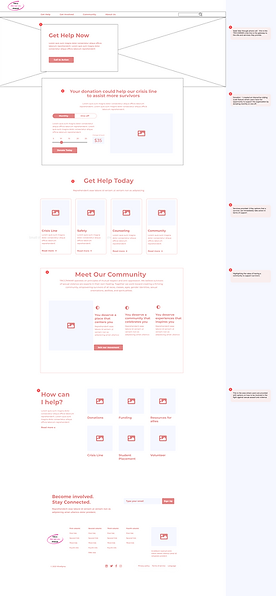
Wireframe 3
3rd time iterating the wireframe. As I continuously evolve the wireframe I was also paying attention to the words used to describe the user’s emotions. This allows the site to resonate more with the user.
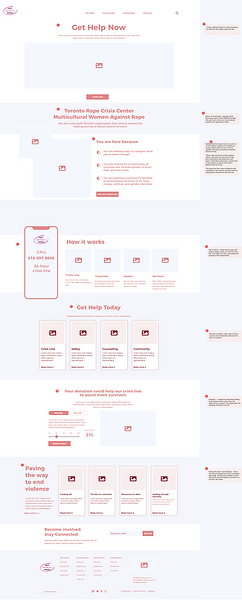
Hi-Fi Mockup of TRCC/MWAR Landing Page
Applying all the initial research, wireframes, and visual elements together. Here we have the proposed landing page for TRCC/MWAR.
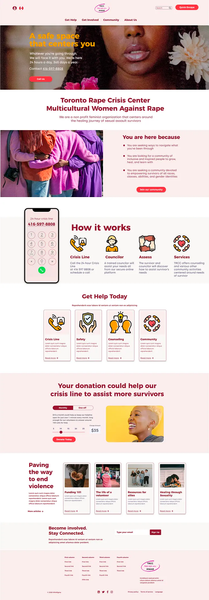

Take away
Through a responsive web design, we are providing people resources, information, and steps on how to support sexual assault survivors.
This design process has allowed me to use my skills and expertise in product design by supporting communities that can reduce the number of sexual violence.
“Sexual violence crosses all social boundaries, affects people of every age and cultural background, and has devastating impacts on the lives of survivors and their families as well as the well-being of society.” -Ministry of Children, Community and Social Services
